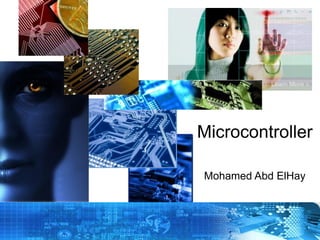More Related Content
Similar to Microcontroller (20)
Microcontroller
- 1. Copyright © 2012 Embedded Systems
Committee
Microcontroller
Mohamed Abd ElHay
- 2. Copyright © 2012 Embedded Systems
Committee
• Number of I/O pins required
• Interfaces/peripherals required
• Memory requirements
• Number of interrupts required
• Real-Time considerations
• Development environment
• Processing speed required
• Memory architecture
• Power requirements
• Life cycle costs
• Vendor support
- 4. Copyright © 2012 Embedded Systems
Committee
AVR was developed in the year 1996 by Atmel
Corporation.
The architecture of AVR was developed by Alf-Egil
Bogen and Vegard Wollan.
AVR derives its name from its developers and stands
for Alf-Egil Bogen Vegard Wollan RISC
microcontroller.
- 5. Copyright © 2012 Embedded Systems
Committee
Also known as Advanced Virtual RISC.
The AT90S8515 was the first microcontroller
which was based on AVR architecture.
The first microcontroller to hit the commercial
market was AT90S1200 in the year 1997.
- 6. Copyright © 2012 Embedded Systems
Committee
1.TinyAVR :
• Less memory
• small size
• suitable only for simpler applications.
- 7. Copyright © 2012 Embedded Systems
Committee
2.MegaAVR :
• These are the most popular ones
• having good amount of memory (upto 256 KB)
higher number of inbuilt peripherals
• suitable for moderate to complex applications.
- 8. Copyright © 2012 Embedded Systems
Committee
3. XmegaAVR :
Used commercially for complex applications, which
require large program memory and high speed.
- 11. Copyright © 2012 Embedded Systems
Committee
AVR microcontrollers are fast:
• executes most of the instructions in single execution
cycle.
• AVRs are about 4 times faster than PICs.
• they consume less power and can be operated in
different power saving modes.
• Free IDE.
• Available in Egyptian market.
- 12. Copyright © 2012 Embedded Systems
Committee
comparison between the three most commonly used
families of microcontrollers:
- 14. Copyright © 2012 Embedded Systems
Committee
• AVR follows Harvard Architecture
the processor is equipped with separate memories and
buses for Program and the Data information. Here
while an instruction is being executed, the next
instruction is pre-fetched from the program memory.
- 15. Copyright © 2012 Embedded Systems
Committee
• The AVR microcontrollers are based on the advanced
RISC architecture and consist of 32 x 8-bit general
purpose working registers.
• Within one single clock cycle, AVR can take inputs from
two general purpose registers and put them to ALU for
carrying out the requested operation.
• AVR does not have any register like accumulator as in
8051 family of microcontrollers.
• the operations can be performed between any of the
registers and can be stored in either of them
- 18. Copyright © 2012 Embedded Systems
Committee
There are two flavors for Atmega16 microcontroller:
1. Atmega16:- Operating frequency range is 0 – 16 MHz.
2. Atmega16L:- Operating frequency range is 0 – 8 MHz.
If we are using a crystal of 8 MHz = 8 x 106 Hertz =
8 Million cycles, then AVR can execute 8 million
instructions.
- 20. Copyright © 2012 Embedded Systems
Committee
• I/O Ports: Atmega16 has four (PORTA, PORTB,
PORTC and PORTD) 8-bit input-output ports.
• ADC Interface: Atmega16 is equipped with an 8 channel
ADC with a resolution of 10-bits.
• Timers/Counters: Atmega16 consists of two 8-bit and
one 16-bit timer/counter.
• Watchdog Timer: is present with internal oscillator.
Watchdog timer continuously monitors and resets the
controller if the code gets stuck at any execution action for
more than a defined time interval.
- 21. Copyright © 2012 Embedded Systems
Committee
• Internal Calibrated Oscillator:
Atmega16 is equipped with an internal oscillator for
driving its clock. By default Atmega16 is set to operate at
internal calibrated oscillator of 1 MHz.
The maximum frequency of internal oscillator is 8Mhz.
ATmega16 can be operated using an external crystal
oscillator with a maximum frequency of 16MHz.
- 22. Copyright © 2012 Embedded Systems
Committee
• Interrupt: consists of 21 interrupt sources out of which four
are external. The remaining are internal interrupts which
support the peripherals like USART, ADC, Timers etc.
• USART: Universal Synchronous and Asynchronous
Receiver and Transmitter interface is available for
interfacing with external device capable of communicating
serially (data transmission bit by bit).
• General Purpose Registers: Atmega16 is equipped with 32
general purpose registers which are coupled directly with the
Arithmetic Logical Unit (ALU) of CPU.
- 23. Copyright © 2012 Embedded Systems
Committee
• Memory: Atmega16 consist of three different
memory sections:
1.Flash EEPROM: Flash EEPROM. Atmega16 is available
with 16KB of in system programmable Flash EEPROM.
2. Byte Addressable EEPROM: Atmega16 has 512 bytes of
EEPROM.
3. SRAM :Atmega16 is equipped with 1KB of internal
SRAM.
A small portion of SRAM is set aside for general purpose
registers used by CPU and some for the peripheral
subsystems of the microcontroller
- 24. Copyright © 2012 Embedded Systems
Committee
• ISP: (In System Programmable )Flash Memory which
can be programmed without removing the IC from the
circuit.
• SPI: SPI port is used for serial communication between
two devices on a common clock source.
- 25. Copyright © 2012 Embedded Systems
Committee
• TWI: (Two Wire Interface )can be used to set up a
network of devices, many devices can be connected over
TWI interface forming a network, the devices can
simultaneously transmit and receive and have their own
unique address.
• DAC: Atmega16 is also equipped with a DAC interface
which can be used for reverse action performed by ADC

